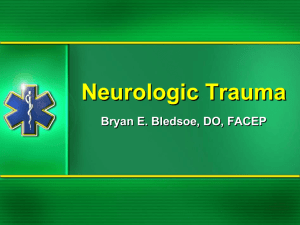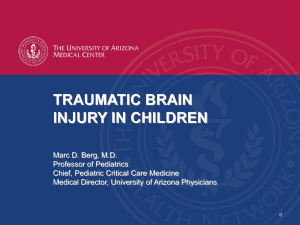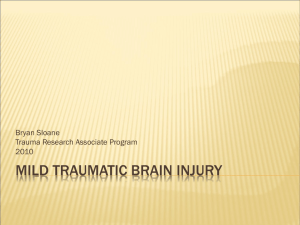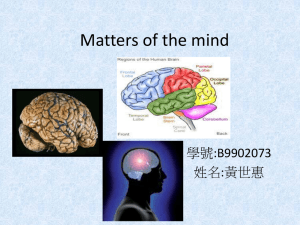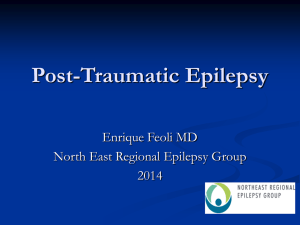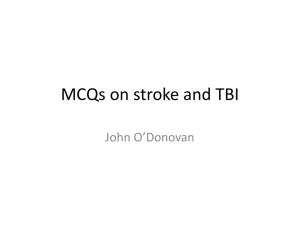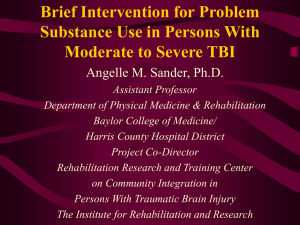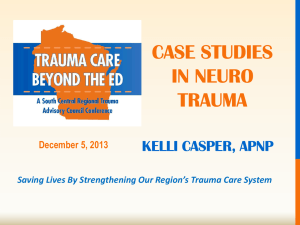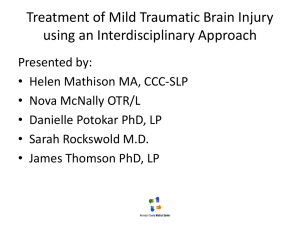Pre-Hospital Management of Traumatic Brain Injury
advertisement
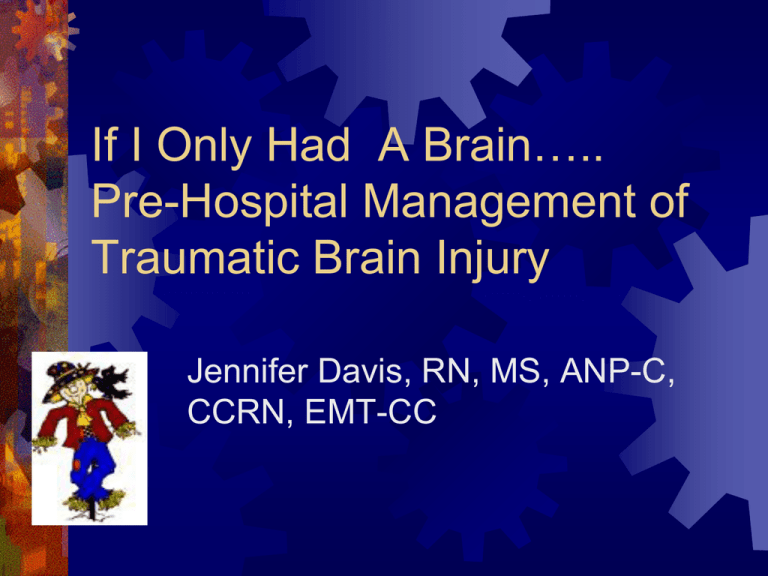
If I Only Had A Brain….. Pre-Hospital Management of Traumatic Brain Injury Jennifer Davis, RN, MS, ANP-C, CCRN, EMT-CC Incidence Traumatic Brain Injury, or TBI, is the leading cause of death and disability in children and adults from ages 1-44 Most often caused by motor visual crashes, sports injuries, or simple falls on the playground, at work, or in the home Approximately 52,00 deaths occur from TBI annually An estimated 1.5 million head injuries are seen yearly in Emergency Departments An estimated 1.6 to 3.8 million sports related TBIs occur each year Facts about TBI At least 5.3 million Americans, 2% of the US population, currently live with disabilities resulting from TBI Moderate and severe head injury (respectively) is associated with a 2.3 and 4.5 times increased risk of Alzheimer’s disease Males are 2x more likely to suffer TBI that females The leading causes of TBI are falls, MVC, and assaults Facts about TBI TBI hospitalization rates have increased from 79% per 100,000 in 2002 to 87.9% per 100,000 in 2003 Exposures to blasts are a leading cause of TBI among active duty military personnel in war zones Veteran’s advocates believe that between 10 and 20% of Iraq war veterans, or 150,000 and 300,000 members have some level of TBI 30% of soldiers admitted to Walter Reed have been diagnosed with a TBI Prevention The best way to treat TBI is prevention Bicycle helmets Seat belt use Motorcycle helmets – full face Helmets Not just for kids! Wearing a bicycle helmet reduces risk of TBI by 88% Only 1% of people admitted to a trauma center after a bicycling accident were wearing helmets Skateboarding Rollerblading Scooters At risk behaviors Males 2 times > injury rate than females Where does EMS fit in? EMS providers are the first contact a patient has into the trauma system We have the ability to prevent secondary brain injury with the right interventions brain injury – the initial brain injury sustained as a result of trauma Secondary injury – the injury that occurs due to hypoxemia and hypovolemia Primary Classification of TBI Mild TBI (GCS 13-15) (MOST of what EMS will see) Concussive syndrome Reversible, temporary LOC/retrograde amnesia Change in mental status a the time of injury only Imaging usually normal Moderate TBI (GSC 9-12) LOC and/or post amnesia of > 30 minutes but < 24 hours GCS – 9-12 Physical, cognitive, and/or behavioral impairments last for months or are permanent Generally make a good recovery with treatment or learn to compensate for deficits Classification of TBI Severe TBI (GCS 3-8) LOC or post-traumatic amnesia > 24 hours GCS lower More extensive physical impairments as a result if brain damage Slower course of recovery Clear indication of significant, permanent deficits What these are depend on location of injury Classification of TBI Very severe/catastrophic TBI True comas of many weeks or months This term is reserved for the most severely damaged head injury Many never regain consciousness or regain meaningful communication with the environment “Persistent vegetative state” Brain Death Results from a severe insult to the brain No cortical or brain stem activity No movement to stimuli No brain stem reflexes No spontaneous breathing Not diagnosed in the field If the brain is dead, the person is dead Concussion Traumatic, REVERSIBLE neurological deficit Temporary LOC Retrograde amnesia Etiology Strong, rapid acceleration-deceleration injury Blow to the head There is a temporary cessation of the functioning of the reticular activating system RAS responsible for arousal or wakefulness of the brain Concussion Assessment Subjective Data HPI Medical Hx Neuro disease, recent trauma, prior head injury Objective Data Mechanism, consciousness immediately after event, duration of event, neuro events after event Physical exam – neuro exam, memory assessment May have repetitive speech and questions Diagnostics CT scan – R/O bleed Interventions for Concussion Immobilization as necessary Emotional support High flow oxygen Planning/Interventions for Concussion Post Concussive Syndrome Results from repeated mild brain injuries over a period of months or years Can impact neurological, behavioral and cognitive function “second impact syndrome” now called Chronic Traumatic Encephalopathy or CTE Muhammad Ali, Football players Once a person suffers a concussion, they are four times more likely to suffer another one. Skull Fracture Types Linear Depressed Damages underlying cerebral tissue by compression or laceration and by retained bony fragments Basilar Most common Account for about 70% of all types Usually benign unless it crosses a major vascular channel Can occur within any of the fossae Clinical picture depends on the area affected Complications include infection, hematoma, CSF leaks, loss of smell, loss of hearing, seizures and pneumocephalus. Skull Fracture Assessment Subjective Data HPI Recent trauma, elapsed time, sweet or salty taste in back of throat, post nasal drip Medical Hx Trauma, malignancy Skull Fracture Objective Data Physical Exam Surface trauma, AMS, altered pupil or motor response, CSF leak, Raccoon eyes, Battle’s sign Diagnostics Halo Test (ottorrhea or rhinorrhea) Using a 4X4 collect fluid leak from nose or ear Set on the bedside table for a few minutes Positive when there is a circular separation of blood and clear fluid or a “halo” Indicative of a CSF leak Halo Sign Depressed Skull Fx Linear Skull Fx Basilar Skull Fx Basilar Skull Fx Battle’s Sign Raccoon Eyes Diffuse Axonal Injury (DAI) DAI is the widespread disruption of neuro function without any focal lesions Characterized by microscopic damage to the axons, diffuse white matter degeneration, global neuro dysfunction and diffuse cerebral edema. Etiology Acceleration-deceleration MVC, Pedestrian, Shaken Baby Shear injury DAI Assessment Subjective Data HPI Mechanism of injury, onset and duration of LOC Medical Hx Neuro disease or injury Substance abuse Child abuse or exam doesn’t fit with mechanism of injury Shaken baby DAI Objective Data Physical Exam Immediate LOC, lasts days to months Increased ICP Brain stem dysfunction Decortication or decerebration Loss of brain stem reflexes – cough, gag, etc. Hypertension Hyperthermia Diaphoresis DAI DAI Cerebral Contusion Cerebral contusion is an actual bruising of the brain Results in focal ischemia and edema with potential for infarction, necrosis and/or ↑ ICP Etiology Trauma, acceleration/deceleration, high velocity blows, or rotation of the brain following a blow Coup – contra coup injury Clinical picture varies depending on area involved Cerebral Contusion Assessment Subjective Data HPI Mechanism of injury, changes in LOC since event Medical Hx Neuro disease or injury Substance abuse Cerebral Contusion Objective Data Physical exam Altered LOC > than a few hours Surface trauma Full neuro exam Cerebral Contusion Subdural Hematoma (SDH) SDH is a collection of blood between the dura matter and the subarachnoid layer of the meninges Usually caused by trauma or as the extension of an intracerebral hematoma into the subdural space Subdural Hematoma (SDH) Three classifications Acute - onset within 48 hours of presentation Sub-acute – onset 2-14 days Chronic – more than 14 days Subdural Hematoma (SDH) Assessment Subjective Data HPI Mechanism of injury, time interval, trends in neuro status Medical Hx ETOH Abuse Chronic SDH common in these pts secondary to multiple falls and abnormal bleeding tendencies secondary to impaired liver function Subdural Hematoma (SDH) Medical History Use of blood thinners or anti-platelet agents Coumadin® (warfarin), Pradaxa® (dabigatran), Plavix® (clopridogrel), Effient® (prasugrel), Lovenox® (enoxaparin), Aggrenox® Many patients on blood thinners or anti-platelet agents many have minor trauma or low mechanism, but should be evaluated in ER as even very minor trauma in these patients can cause hemorrhage Subdural Hematoma (SDH) Objective Data Physical Exam Acute Headache, drowsiness, confusion Steady decline in LOC Ipsilateral , unilateral pupil dilation with lack of response to light – LATE finding Contra lateral hemiparesis Chronic and sub acute Gradual and non-specific changes Altered mentation Altered motor status Ipsilateral pupil dilation and sluggish to light Subdural Hematoma (SDH) Acute SDH with left to right shift Subdural Hematoma (SDH) Chronic SHD (gray) with acute SHD component (white) Epidural Hematoma (EDH) Collection of blood between the skull and dura Etiology Usually from a laceration of the middle meningeal artery associated with skull fx The arterial bleed in under high pressure – it does not tamponade, but rather progresses to become a space occupying lesion causing ↑↑ ICP, brain shift and herniation Mortality = 50% if not treated Epidural Hematoma (EDH) Assessment Subjective Data HPI Mechanism of injury PATTERN of unconsciousness Initially unconscious, followed by a lucid period, then followed by rapid unconsciousness Medical Hx Previous trauma, previous head injury Epidural Hematoma (EDH) Objective Data Physical exam Altered LOC, pupils with unilateral dilation, fixed and/or dilated, contralateral paresis or paralysis which leads to posturing Cushing’s triad Abnormal respirations Narrowing pulse pressure Bradycardia Diagnostics Rapid CT exam at trauma center Epidural Hematoma (EDH) Notice the scalloping, rather than layering of the blood. EDH Frequent neuro checks ABC’s Prepare for emergency surgery Transport to a facility with neurosurgery capabilities TRUE Neurosurgical emergency! Increased ICP ICP is influenced by relatively fixed volumes The brain The blood The CSF 80% 10% 10% Total volume Monroe-Kellie Hypothesis to maintain a normal ICP, a change in the volume of one compartment must be offset by a reciprocal change in the volume of another compartment Increased ICP Etiology – Any condition that: Increases space occupying lesions SDH, masses, cerebral edema, EDH, ICB Increases blood volume Venous outflow obstruction, hyperemia (HTN), hypercapnia Increases brain volume CSF Hydrocephalus, SAH, lack of absorption of CSF Increased ICP Assessment Subjective Data HPI Chronology Consciousness Mentation Personality Communication Nausea Pain Seizures Vomiting Motor deficits Headaches Visual changes Increased ICP Medical History Neuro disease Trauma Fainting Substance abuse Especially cocaine, heroin Medications Allergies Increased ICP Objective Data Physical Exam EARLY picture of ↑ ICP LOC – changes may be SUBTLE. Changes in LOC may be the FIRST sign of ↑ ICP Pupils – sluggish, different bilaterally Ipsilateral/unilateral changes Motor function LISTEN to the patient’s family – they know their loved one BEST! Contralateral changes Vital Signs Increased ICP LATE picture of ↑ICP LOC Arouses only with deep noxious stimuli, or unresponsive Pupils Motor function Fixed and dilated or “blown” Hemiparesis, posturing, or flaccidity Vital Signs Cushings Triad Bradycardia Narrowing pulse pressure Slow or irregular respirations Hyperventilation Hyperventilation in Traumatic Brain InjuryOnly used when: GCS < 8 plus Active seizure Posturing Increased BP and decreased pulse Intermittent apnea Further decrease of GCS >2 on subsequent exam Adult – 20 breaths per minute Child – 25 breaths per minute Get With The Guidelines Brain Trauma Foundation Guidelines for the Pre-Hospital Treatment of Traumatic Brain Injury Treatment for TBI Oxygenation Hypoxemia and Blood Pressure (<90% O2 Sat) or hypotension (<90 mm Hg SBP) are significant parameters associated with a poor outcome in patients with severe head injury in the pre-hospital setting In children the parameters are SBP<65 (01 years old), <75 (2-5 years old), <80 (6-12 years old) and <90 (13-16 years old Treatment for TBI High Flow 02 all patients Assist ventilations as necessary per protocol Avoid nasal airways in those patients with facial injury and/or suspected basilar skull fx Raising BP in hypotensive, severe head injury patients improves outcome in proportion to the efficacy of the resuscitation If ALS – IV NS Open until SPB >90, or up to 2 liters infused then contact Medical Control Glasgow Coma Score (GCS) pre-hospital measurement of GCS is a significant and reliable indicator of severity of head injury particularly in association with repeated scoring and improvement or deterioration of the score over time A GCS score of 3 to 5 has at least a 70% positive predictive value for poor outcome GCS Best Eye Response. (4) 1.No eye opening. 2.Eye opening to pain. 3.Eye opening to verbal command. 4.Eyes open spontaneously. GCS Best Verbal Response. (5) 1.No verbal response 2.Incomprehensible sounds. 3.Inappropriate words. 4.Confused 5.Orientated GCS Best Motor Response. (6) 1.No motor response. 2.Extension to pain. 3.Flexion to pain. 4.Withdrawal from pain. 5.Localizing pain. 6.Obeys Commands. GCS Note that the phrase 'GCS of 11' is essentially meaningless, and it is important to break the figure down into its components, such as E3V3M5 = GCS 11. A Coma Score of 13 or higher correlates with a mild brain injury, 9 to 12 is a moderate injury and 8 or less a severe brain injury. Teasdale G., Jennett B., LANCET (ii) 81-83, 1974. Pupillary Assessment Pupil examination is a standard component of the pre-hospital neuro exam The pupillary exam along with the GCS will serve as a baseline for ALL subsequent examinations in the ER and hospital Pupillary Assessment Pre-hospital pupil exam should consist of: The pupil size and light reflex Assess and document on the PCR The duration of the pupillary dilation and fixation should be assessed and documented Brisk reaction to light Sluggish reaction to light No reaction to light Anisocoria Airway, Ventilation, and Oxygenation GUIDELINES Hypoxemia (apnea, cyanosis, Sat <90%) MUST be avoided or corrected immediately Sats should be monitored, if available, on all patients with TBI Hypoxemia should be treated with supplemental O2 In NYS and Suffolk – all trauma patients should be given high flow 02 Airway, Ventilation, and Oxygenation Options Airway should be secured in pts with GCS<9, the inability to maintain an adequate airway, or hypoxemia not corrected by supplemental O2 Endotracheal intubation is the most effective way to maintain a difficult airway Intubate only if possible – i.e. teeth not clenched, avoid prolonged attempts as this will increase ICP In peds, BVM ventilation is just as effective as long as you are getting chest rise Airway, Ventilation, and Oxygenation AVOID prophylactic hyperventilation Patients should be maintained with normal breathing rates (ETCO2 35-40 mmHg), and hyperventilation (ETCO2 < 35 mmHg) should be avoided unless the patient shows signs of cerebral herniation Hyperventilation 20 breaths per minute in an adult 25 breaths per minute in a child 30 breaths per minute in an infant less than 1 year old For ALS providers: The goal of hyperventilation is ETCO2 of 30-35 mmHg. Capnography is the preferred method for monitoring ventilation Fluid Resuscitation Fluid resuscitation in patients with TBI should be administered to avoid hypotension and/or limit hypotension to the shortest duration possible In Suffolk Up to 2 large bore IV’s with NS open until SBP >90 or up to 2 liters NS infused, then contact with MC KVO for SBP > 90 Hypoglycemia Hypoglycemia has been associated with traumatic events – it exhibits signs similar to that of patients with TBI I.e. MVA secondary to low blood sugar Blood sugar should be checked in all patients with AMS of undetermined etiology Treat hypoglycemia Transport Decisions Patients with severe TBI and a GCS <9 should be transported to a facility with the following capabilities: Immediate CT Scanning Prompt neurosurgical care Ability to monitor ICP and treat increased ICP For all intents and purposes, this is a trauma center GSH SSH BMH UHSB Case Study You are dispatched to the scene of a motorcycle vs. car – BLS ambulance On scene you find: Approximately 20 year old male lying prone Ninja motorcycle Full face helmet in place but not intact Motorcycle is found approximately 50 feet from where you find your patient You notice bilateral femur deformities Case Study Patient is unresponsive to verbal stimuli Upon rolling your patient, while maintaining cervical stabilization, of course, you open the visor of the helmet and determine that the patient is not maintaining an adequate airway and you…………………….. Remove helmet per NYS protocols Obvious depression In the occiput of the pt’s head Using a jaw thrust, open the airway, look, listen and feel for breathing You determine that he is not able to maintain his airway and that he is breathing irregularly Case Study Place an oral airway Begin BVM ventilations Check for a distal pulse – 120 and weak Check BP – 80/30 GCS of 6 Decerebrate posturing You take a step back, and think to yourself… Oh Crap! No – ABC’s are taken care of, now what must I do to maintain this patient Call for ALS to scene While waiting for ALS, rapid transport decision, immobilize in c-collar and place on LBB, get patient ready for transport. Do not wait on scene for ALS!!!! Case Study ALS – intervene enroute to trauma center Remember the standards/guideline for prehospital management of TBI Airway/Breathing Circulation Is it adequate with the OPA in place, is there chest rise, can I safely intubate this patient and not do further harm What is the pulse and BP IV access NS open for SBP >90 or up to 2 liters Hyperventilation Do I need to do it? – In this patient, yes, mild hyperventilation of 20 BPM is appropriate based on his physical assessment and neuro exam Case Study Are my interventions helping? Re-assess ABC’s Re-assess GCS Re-assess Vitals
